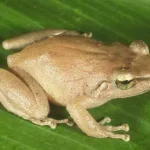Last June, the Department of Agriculture confirmed invasive coqui frogs had been found at higher elevations than previous infestations on Oʻahu following a report from a citizen.
Surveys were subsequently performed by the DLNR Division of Forestry and Wildlife (DOFAW), and the Oʻahu Invasive Species Committee (OISC). It is estimated that 13 acres of forest are infested below the Kuliʻouʻou summit on the leeward side. The new infestation site presents several logistical challenges for response efforts as steep slopes are inaccessible by foot. Highly variable weather prevent crews from using a traditional hose-based spray system to deliver a non-toxic citric food additive mixed with water used to control the frogs. Due to these difficulties, DOFAW field staffers are planning to use drone technology to apply the citric treatment at these higher elevations. Aloha ʻĀina Drones, a Hilo-based operation specializing in agricultural and conservation drone applications, is contracted to do the work.
In Hawaiʻi, coqui reach densities much higher than in their native Puerto Rico. Their loud calls disturb residents and have large impacts on local insect communities. Coqui are now widespread on Hawaiʻi Island and are targets of control efforts on Kauaʻi, Oʻahu and Maui.
To date, the frogs have not been detected at lower elevations on the leeward side of the Koʻolau Mountains.
Kuliʻouʻou residents and hikers on the Kuliʻouʻou Ridge Trail and Kuliʻouʻou Valley Trail are encouraged to listen for frog calls. Pest reports can be submitted online at 643pest.org or by calling the 643-PEST telephone hotline.
DLNR Photo
